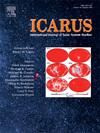Mapping of potential mass wasting on Enceladus
IF 2.5
2区 物理与天体物理
Q2 ASTRONOMY & ASTROPHYSICS
引用次数: 0
Abstract
Enceladus is a moon of Saturn that is known to exhibit active geology in the form of geysers that erupt from the south pole. Mass wasting (e.g., landsliding) is another process that can actively shape planetary surfaces and provide insight into the geological activity of a planetary body. We performed mapping of Enceladus' surface to investigate the distribution of potential areas of mass wasting, as well as the presence of ice boulders near these areas which could be displaced downhill by the mass wasting events. Twenty-five images taken by the Cassini spacecraft, selected based on those with the highest resolution (12–200 m/pixel), were used in our survey. Within those images, we find 84 areas of potential mass wasting. We find a correlation between ice blocks and mass wasting at tectonic sites; however, at craters we do not find ice blocks even though potential mass wasting sites were found. An explanation of the processes leading to the dearth of ice blocks in craters could be the topic of future work.
求助全文
约1分钟内获得全文
求助全文
来源期刊

Icarus
地学天文-天文与天体物理
CiteScore
6.30
自引率
18.80%
发文量
356
审稿时长
2-4 weeks
期刊介绍:
Icarus is devoted to the publication of original contributions in the field of Solar System studies. Manuscripts reporting the results of new research - observational, experimental, or theoretical - concerning the astronomy, geology, meteorology, physics, chemistry, biology, and other scientific aspects of our Solar System or extrasolar systems are welcome. The journal generally does not publish papers devoted exclusively to the Sun, the Earth, celestial mechanics, meteoritics, or astrophysics. Icarus does not publish papers that provide "improved" versions of Bode''s law, or other numerical relations, without a sound physical basis. Icarus does not publish meeting announcements or general notices. Reviews, historical papers, and manuscripts describing spacecraft instrumentation may be considered, but only with prior approval of the editor. An entire issue of the journal is occasionally devoted to a single subject, usually arising from a conference on the same topic. The language of publication is English. American or British usage is accepted, but not a mixture of these.
 求助内容:
求助内容: 应助结果提醒方式:
应助结果提醒方式:


